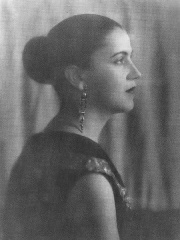
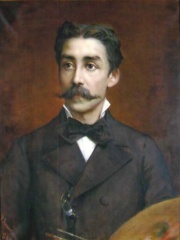
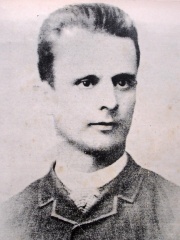
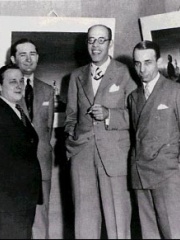
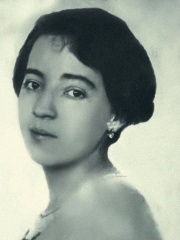
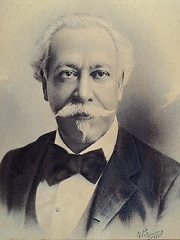
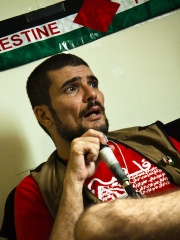
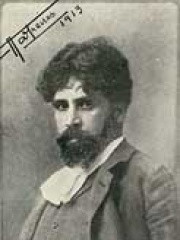
The Most Famous
PAINTERS from Brazil
Top 10
The following people are considered by Pantheon to be the top 10 most legendary Brazilian Painters of all time. This list of famous Brazilian Painters is sorted by HPI (Historical Popularity Index), a metric that aggregates information on a biography's online popularity. Visit the rankings page to view the entire list of Brazilian Painters.

1. Tarsila do Amaral (1886 - 1973)
With an HPI of 63.74, Tarsila do Amaral is the most famous Brazilian Painter. Her biography has been translated into 25 different languages on wikipedia.
Tarsila de Aguiar do Amaral (Portuguese pronunciation: [taʁˈsilɐ du ɐmaˈɾaw]; 1 September 1886 – 17 January 1973) was a Brazilian painter, draftswoman, and translator. She is considered one of the leading Latin American modernist artists, and is regarded as the painter who best achieved Brazilian aspirations for nationalistic expression in a modern style. As a member of the Grupo dos Cinco, Tarsila is also considered a major influence in the modern art movement in Brazil, alongside Anita Malfatti, Menotti Del Picchia, Mário de Andrade, and Oswald de Andrade. She was instrumental in the formation of the aesthetic movement, Antropofagia (1928–1929); in fact, Tarsila was the one with her celebrated painting, Abaporu, who inspired Oswald de Andrade's famous Manifesto Antropófago.

2. Pedro Américo (1843 - 1905)
With an HPI of 62.91, Pedro Américo is the 2nd most famous Brazilian Painter. His biography has been translated into 32 different languages.
Pedro Américo de Figueiredo e Melo (29 April 1843 – 7 October 1905) was a Brazilian novelist, poet, scientist, art theorist, essayist, philosopher, politician and professor, but is best remembered as one of the most important academic painters in Brazil, leaving works of national impact. From an early age he showed an inclination towards the arts, being considered a child prodigy. At a very young age, he participated as a draftsman on an expedition of naturalists through the Brazilian northeast, and received government support to study at the Imperial Academy of Fine Arts. He did his artistic improvement in Paris, studying with famous painters, but he also dedicated himself to science and philosophy. Soon after his return to Brazil, he began to teach at the academy and began a successful career, gaining prominence with great paintings of a civic and heroic character, inserting himself in the civilizing and modernizing program of the country fostered by emperor Pedro II, of which the Imperial Academy was the regulatory and executive arm in the artistic sphere. His style in painting, in line with the great trends of his time, fused neoclassical, romantic and realistic elements, and his production is one of the first great expressions of Academicism in Brazil in its heyday, leaving works that remain alive in the collective imagination of the nation to this day, such as Batalha de Avaí, Fala do Trono, Independência ou Morte! and Tiradentes Esquartejado, reproduced in school books across the country. In the second half of his career, he concentrated on oriental, allegorical and biblical themes, which he personally preferred and whose market was expanding, but this part of his work, popular at the time, quickly went out of fashion, and did not receive much attention from specialists in recent times remaining little known. He spent his career between Brazil and Europe, and in both places his talent was recognized, receiving great favors from critics and the public but also raising passionate controversies and creating tenacious opponents. For the new avant-gardes of his time, Pedro Américo was a painter of undeniably rare gifts, but above all he became one of the main symbols of everything that the academic system allegedly had as conservative, elitist and distant from the Brazilian reality. His great artistic merits make him one of the greatest painters the country has ever produced, and his fame and influence in life, the burning debates he aroused in his institutional, cultural and political performance, in a critical moment of articulation of a new system of symbols for a country just emerging from the condition of colony and of consolidation of a new system of art on modern methodological and conceptual bases, highlight him as one of the most important names in the history of Brazilian culture at the end of the 19th century. He acquired an intellectual sophistication quite unusual for Brazilian artists of his time, taking an interest in a wide variety of subjects and seeking solid preparation. He obtained a Bachelor of Arts in Social Sciences from the Sorbonne and a PhD in Natural Sciences from the Free University of Brussels. He was director of the antiquities and numismatics section of the Imperial and National Museum; professor of drawing, aesthetics and art history at the Imperial Academy, and constituent deputy for Pernambuco. He left a large written production on aesthetics, art history and philosophy, where, inspired by the classical model, he gave special attention to education as the basis of all progress and reserved a superior role for art in the evolution of humanity. He won several honors and decorations, including the title of Historical Painter of the Imperial Chamber, the Order of the Rose and the Order of the Holy Sepulchre. He also left some poetry and four novels, but like his theoretical texts, they are little remembered today.

3. José Ferraz de Almeida Júnior (1850 - 1899)
With an HPI of 61.06, José Ferraz de Almeida Júnior is the 3rd most famous Brazilian Painter. His biography has been translated into 22 different languages.
José Ferraz de Almeida Júnior (8 May 1850 – 13 November 1899) was a Brazilian artist and designer; one of the first there to paint in the Realistic tradition of Gustave Courbet and Jean-François Millet. The "Dia do Artista Plástico" (Day of Fine Artists in Brazil) is celebrated on his birthday.

4. Candido Portinari (1903 - 1962)
With an HPI of 60.19, Candido Portinari is the 4th most famous Brazilian Painter. His biography has been translated into 32 different languages.
Candido Portinari (December 29, 1903 – February 6, 1962) was a Brazilian painter. He is considered one of the most important Brazilian painters as well as a prominent and influential practitioner of the neo-realism style in painting. Portinari painted more than five thousand canvases, from small sketches to monumental works such as the Guerra e Paz panels, which were donated to the United Nations Headquarters in 1956. Portinari developed a social preoccupation throughout his oeuvre and maintained an active life in the Brazilian cultural and political worlds.

5. Lygia Clark (1920 - 1988)
With an HPI of 59.57, Lygia Clark is the 5th most famous Brazilian Painter. Her biography has been translated into 17 different languages.
Lygia Pimentel Lins (23 October 1920 – 25 April 1988), better known as Lygia Clark, was a Brazilian artist best known for her painting and installation work. She was often associated with the Brazilian Constructivist movements of the mid-20th century and the Tropicalia movement. Along with Brazilian artists Amilcar de Castro, Franz Weissmann, Lygia Pape and poet Ferreira Gullar, Clark co-founded the Neo-Concrete movement. From 1960 on, Clark discovered ways for viewers (who would later be referred to as "participants") to interact with her art works. Clark's work dealt with the relationship between inside and outside, and, ultimately, between self and world.

6. Anita Malfatti (1889 - 1964)
With an HPI of 57.27, Anita Malfatti is the 6th most famous Brazilian Painter. Her biography has been translated into 18 different languages.
Anita Catarina Malfatti (December 2, 1889 – November 6, 1964) is heralded as the first Brazilian artist to introduce European and American forms of Modernism to Brazil. Her solo exhibition in São Paulo, in 1917–1918, was controversial at the time, and her expressionist style and subject were revolutionary for the complacently old-fashioned art expectations of Brazilians who were searching for a national identity in art, but who were not prepared for the influences Malfatti would bring to the country. Malfatti's presence was also highly felt during the Week of Modern Art (Semana de Arte Moderna) in 1922, where she and the Group of Five made huge revolutionary changes in the structure and response to modern art in Brazil.

7. Victor Meirelles (1832 - 1903)
With an HPI of 56.92, Victor Meirelles is the 7th most famous Brazilian Painter. His biography has been translated into 19 different languages.
Victor Meirelles de Lima (18 August 1832 – 22 February 1903) was a Brazilian painter and teacher who is best known for his works relating to his nation's culture and history. From humble origins, his talent was soon recognized, being admitted as a student at the Imperial Academy of Fine Arts. He specialized in the genre of history painting, and upon winning the Academy's Foreign Travel Award, he spent several years training in Europe. There he painted his best-known work, Primeira Missa no Brasil. Returning to Brazil, he became one of emperor Pedro II's favorite painters, joining the monarch's patronage program and aligning himself with his proposal to renew the image of Brazil through the creation of visual symbols of its history. He became an esteemed teacher at the Academy, forming a generation of painters, and continued his personal work by performing other important historical paintings, such as Batalha dos Guararapes, Moema and Combate Naval do Riachuelo, as well as portraits and landscapes, of which the Retrato de Dom Pedro II and his three Panoramas stand out. In his heyday he was considered one of the leading artists of the second reign, often receiving high praise for the perfection of his technique, the nobility of his inspiration and the general quality of his monumental compositions, as well as his unblemished character and tireless dedication to his craft. Meirelles got many admirers both in Brazil and abroad. He received imperial decorations and was the first Brazilian painter to win admission to the Paris Salon, but was also the target of scathing criticism, arousing strong controversies in a period when disputes between academic painters and the early modernists were ignited. With the advent of the Republic in Brazil, for being too linked to the Imperial government, he fell into ostracism, and ended his life in precarious financial conditions, already much forgotten. Meirelles' works belong to the Brazilian academic tradition, formed by an eclectic synthesis of neoclassical, romantic and realist references, but the painter also absorbed Baroque and Nazarene influences. After a period of relative obscurity, recent criticism has reinstated him as one of the forerunners of modern Brazilian painting and one of the main Brazilian painters of the 19th century, for many the greatest of all, being the author of some of the most celebrated visual recreations of Brazilian history, that remain alive in the country's culture and are endlessly reproduced in school textbooks and a variety of other media.

8. Carlos Latuff (b. 1968)
With an HPI of 55.27, Carlos Latuff is the 8th most famous Brazilian Painter. His biography has been translated into 27 different languages.
Carlos Latuff (born 30 November 1968) is a Brazilian political cartoonist. His work deals with themes such as anti-Western sentiment, anti-capitalism, and opposition to U.S. military intervention in foreign countries. He is best known for his images depicting the Israeli–Palestinian conflict and the Arab Spring. Latuff's cartoons comparing Israel to Nazi Germany have been labelled as antisemitic by some advocacy organisations and scholars. Latuff said the characterization was a dishonest defense of Israel.

9. Antônio Parreiras (1860 - 1937)
With an HPI of 54.53, Antônio Parreiras is the 9th most famous Brazilian Painter. His biography has been translated into 15 different languages.
Antônio Diogo da Silva Parreiras (20 January 1860 – 17 October 1937) was a Brazilian painter, designer, and illustrator.
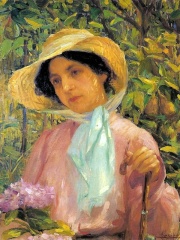
10. Georgina de Albuquerque (1885 - 1962)
With an HPI of 53.92, Georgina de Albuquerque is the 10th most famous Brazilian Painter. Her biography has been translated into 17 different languages.
Georgina de Albuquerque (February 4, 1885 – August 29, 1962) was a Brazilian Impressionist painter and teacher. She was known for her interest in female subjects. Her husband Lucílio was a noted painter in his own right and the two are strongly associated with each other.
People
Pantheon has 10 people classified as Brazilian painters born between 1832 and 1968. Of these 10, 1 (10.00%) of them are still alive today. The most famous living Brazilian painters include Carlos Latuff. The most famous deceased Brazilian painters include Tarsila do Amaral, Pedro Américo, and José Ferraz de Almeida Júnior.
Living Brazilian Painters
Go to all RankingsDeceased Brazilian Painters
Go to all RankingsTarsila do Amaral
1886 - 1973
HPI: 63.74
Pedro Américo
1843 - 1905
HPI: 62.91
José Ferraz de Almeida Júnior
1850 - 1899
HPI: 61.06
Candido Portinari
1903 - 1962
HPI: 60.19
Lygia Clark
1920 - 1988
HPI: 59.57
Anita Malfatti
1889 - 1964
HPI: 57.27
Victor Meirelles
1832 - 1903
HPI: 56.92
Antônio Parreiras
1860 - 1937
HPI: 54.53
Georgina de Albuquerque
1885 - 1962
HPI: 53.92
Overlapping Lives
Which Painters were alive at the same time? This visualization shows the lifespans of the 9 most globally memorable Painters since 1700.

